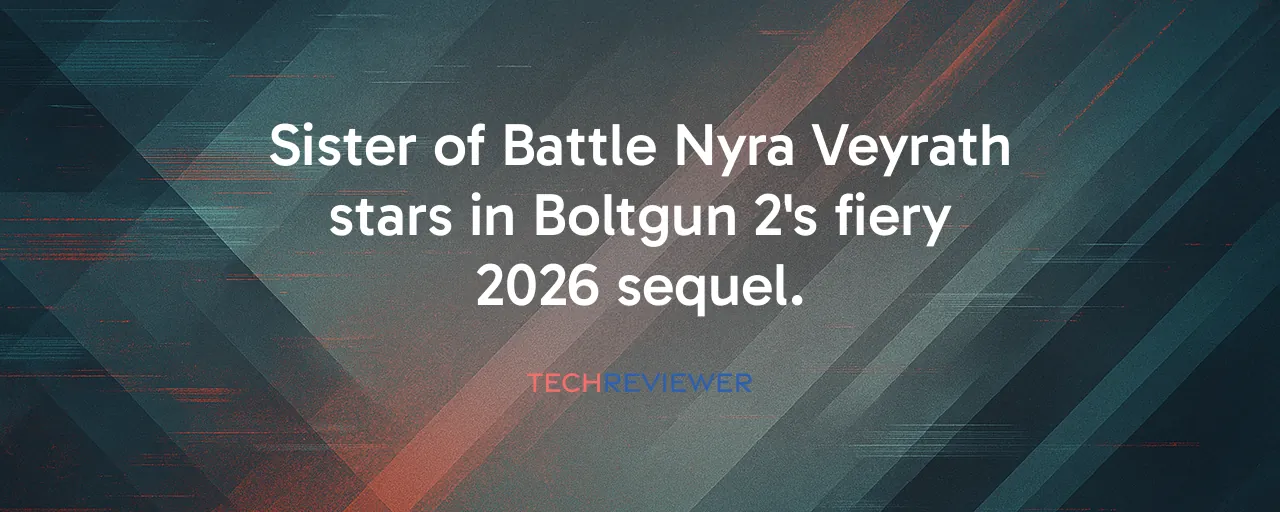A Fiery New Face in the Grimdark
Warhammer 40,000: Boltgun 2, set to land in 2026, throws a blazing curveball into the retro shooter scene with Nyra Veyrath, a Sister of Battle from the Adepta Sororitas. For the first time in the series, players can step into the boots of this fierce Celestian warrior, wielding flame-based weapons and faith-driven powers that feel like a love letter to Warhammer's grimdark lore. Unlike the hulking Space Marine Malum Caedo, who anchored the first game's explosive combat, Nyra brings a faster, more agile playstyle that sets her apart in this pixelated bloodbath.
Auroch Digital, the Bristol-based studio behind the game, knows its Warhammer roots. With over 60 developers and a deep passion for the franchise, they've crafted a sequel that builds on the 2023 original's success, which won over fans with its nod to 1990s shooters like Doom. The choice to spotlight Nyra reflects a broader push by Games Workshop to give the Sisters of Battle their due, a faction long overshadowed by Space Marines in video games despite their tabletop popularity.
Holy Fire Unleashed
Nyra Veyrath's arsenal centers on the Adepta Sororitas' signature 'holy trinity' of weapons: bolter, flamer, and meltagun. These tools of divine retribution let players torch enemies in hive cities and jungle swamps, leaving smoldering ashes in their wake. Her faith-powered abilities, drawn straight from Warhammer lore, add a fresh layer to the fast-paced gunplay. Think temporary buffs or devastating attacks triggered by devotion to the God-Emperor, a mechanic that feels both authentic and thrillingly new.
This shift to faction-specific gameplay creates a contrast with Malum Caedo's tank-like approach. While the Space Marine wields heavy weapons and a chainsword for methodical mayhem, Nyra's speed and fiery attacks reward players who thrive on hit-and-run chaos. Auroch Digital's challenge lies in balancing these distinct styles across a branching campaign, ensuring both characters shine in the game's diverse biomes, from towering urban sprawls to treacherous mangroves.
Branching Paths, Bigger Stakes
Boltgun 2 breaks from the original's linear campaign with a branching structure that lets players shape their journey through multiple narrative paths. Each choice unlocks unique levels and challenges, boosting replayability for Warhammer fans and boomer shooter enthusiasts alike. This ambitious design, paired with new enemies like the brutal Bloodletters and Juggernauts of Chaos, demands tactical flexibility, as players adapt to different combat scenarios based on their chosen hero.
The game's retro aesthetic, with its low-polygon models and sprite-based effects, keeps the 1990s vibe alive while supporting modern performance. A new navigation guide system helps players stay focused on the action, addressing a common gripe in complex retro shooters. By weaving in diverse environments and player-driven storytelling, Auroch Digital aims to deliver a sequel that feels both nostalgic and forward-thinking.
Learning From the Past
To understand Boltgun 2's potential, look at two contrasting case studies. The original Boltgun, launched in 2023, nailed its niche by blending Warhammer's grimdark chaos with arcade-style shooting, earning praise for its authenticity and pace. Its success, driven by a tight focus on retro mechanics, shows how targeting a dedicated audience can pay off. Meanwhile, Warhammer 40,000: Space Marine 2, with its 7 million copies sold since September 2024, proves the franchise's mainstream pull when backed by bigger budgets and polish, though at the cost of higher development demands.
Dusk, another boomer shooter, offers a different lesson. Its lean, no-frills design captivated players with pure gameplay, but lacked the narrative depth Boltgun 2 aims for. Auroch's challenge is to balance this niche appeal with enough innovation to stand out in a crowded market, especially with titles like Prodeus and Ion Fury vying for attention. The addition of Nyra Veyrath, a female protagonist in a male-dominated franchise, could broaden appeal, much like diverse rosters have boosted fighting games, provided the execution feels seamless.
Navigating a Crowded Arena
The boomer shooter scene is thriving, with Steam recognizing it as a distinct genre by 2024 and events like Boomstock 2025 celebrating its growth. Yet, market saturation poses a risk, as fans have plenty of retro FPS options. Warhammer's dense lore can also intimidate newcomers, despite the franchise's strong sales, like Space Marine 2's blockbuster performance. Boltgun 2's single-player focus and retro visuals might not draw players craving modern graphics or multiplayer modes, but its Warhammer branding and Nyra's debut could pull in both loyalists and curious newcomers.
Some worry the three-year development cycle, from the 2023 original to the 2026 sequel, might limit innovation. Auroch Digital must ensure the branching campaign and dual-character system feel robust, not rushed. Still, the studio's track record and Games Workshop's strategic licensing suggest confidence in delivering a polished experience that honors the Adepta Sororitas while keeping the action blisteringly fun.
A Bright Future for Faithful Warriors
Boltgun 2's inclusion of Nyra Veyrath signals a shift toward diversifying Warhammer's gaming roster, a move fans have long requested. By giving the Sisters of Battle a starring role, Auroch Digital taps into a passionate fanbase eager for more faction variety. The game's manageable scope, with lower costs than AAA titles, positions it well within the boomer shooter niche, where quality can trump flashiness.
Looking ahead, Boltgun 2 could pave the way for more Warhammer FPS titles exploring other factions, from Orks to Inquisitors. Its success will hinge on delivering satisfying gameplay for both Nyra and Malum, with enough replayability to keep players hooked. If Auroch nails the balance, this sequel could burn bright in 2026, proving that even in a grimdark future, a fiery new hero can steal the spotlight.
